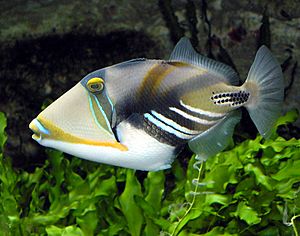Lagoon triggerfish facts for kids
Quick facts for kids Lagoon triggerfish |
|
|---|---|
 |
|
| Scientific classification | |
| Genus: |
Rhinecanthus
|
| Species: |
aculeatus
|
The lagoon triggerfish (Rhinecanthus aculeatus) is a colorful fish that lives on coral reefs. People also call it the blackbar triggerfish, the Picasso triggerfish, or the Picassofish. It can grow up to 30 centimeters (about 1 foot) long. You can find these fish in the Indo-Pacific region, which includes the Indian Ocean and the Pacific Ocean.
In Hawaii, this fish has a very long name: humuhumunukunukuāpuaʻa. This name means "triggerfish with a snout like a pig." Sometimes, people just call it humuhumu for short. This name is also used for another fish, the reef triggerfish, which is the state fish of Hawaii. Scientists have studied the lagoon triggerfish to learn about how fish move and how they see colors.
Fish Behavior
Lagoon triggerfish live in the sandy areas and reefs of coral reefs. They are not picky eaters and will eat almost anything they find. These fish are always swimming around and are very active. They strongly protect their home area from other fish and even divers. This is especially true when they are guarding their eggs.
Lagoon triggerfish are much smaller than their cousin, the titan triggerfish. This means they are not as dangerous as the larger triggerfish.
Reproduction and Life Cycle
Both male and female lagoon triggerfish protect their own territories. Some fish can keep their territory for eight years or even longer. Males usually hold their territories for a longer time than females. A male's territory might overlap with the territories of one to five females. This type of mating system is called "harem-like."
If a male or female fish leaves or disappears, another fish quickly takes over their territory. These fish reproduce many times during their lives.
Mating happens around sunrise. The female fish lays her eggs on sand, coral pieces, or algae. The eggs hatch on the same day, usually around sunset. In many fish, the father takes care of the eggs. But for lagoon triggerfish, the mother guards and cares for the eggs until they hatch.
The mother stays above the eggs for about 12 to 14 hours. She fans the eggs with her fins to give them more oxygen. She also chases away other fish that come too close. She even removes intruders like starfish with her mouth. This care from the mother helps almost all the eggs survive. If the mother is not there, almost no eggs survive. While caring for the eggs, mothers eat less and stay in a smaller area near the eggs.
How They See
Lagoon triggerfish have special cells in their eyes that help them see. They have one type of single cone cell. They also have a "double cone" cell, which is like two cells working together. These cells help them see different colors.
Scientists have studied how these fish behave to understand their vision. Research shows that lagoon triggerfish can see many colors, much like humans do. This means they have "trichromatic vision," which allows them to see a wide range of colors.
-
Lagoon triggerfish swimming around the reef of Fihalhohi, the Maldives.
- Froese, Rainer and Pauly, Daniel, eds. (2005). "Rhinecanthus aculeatus" in FishBase. December 2005 version.
See also
 In Spanish: Ballesta picasso para niños
In Spanish: Ballesta picasso para niños





